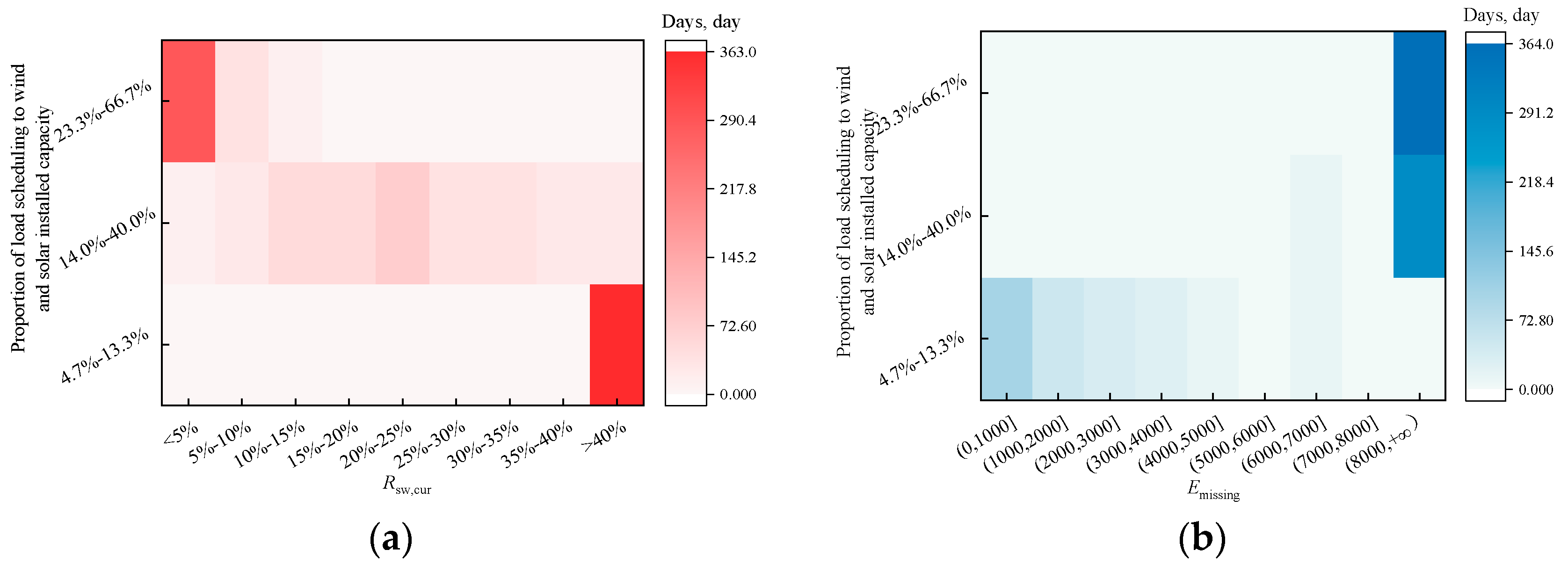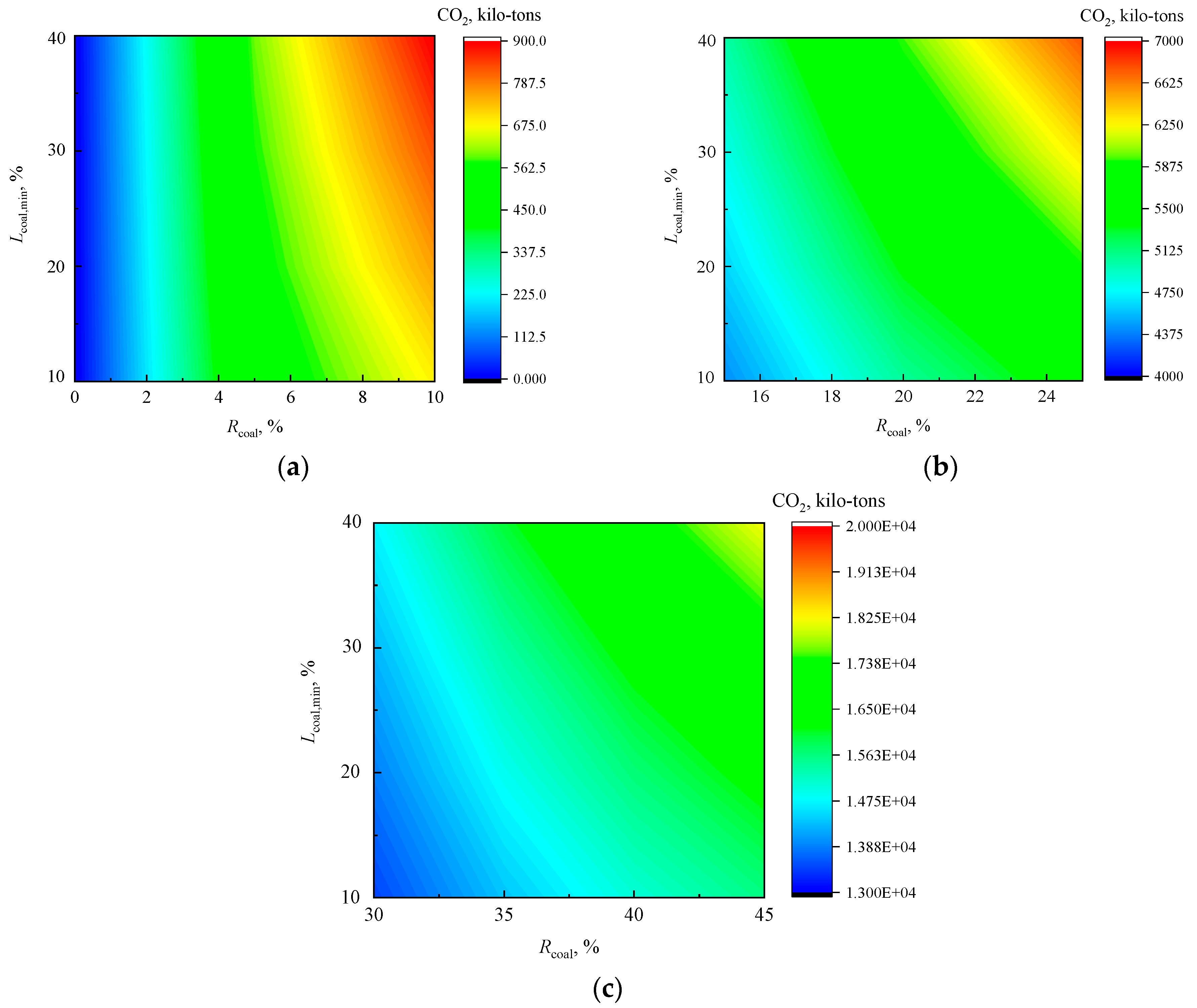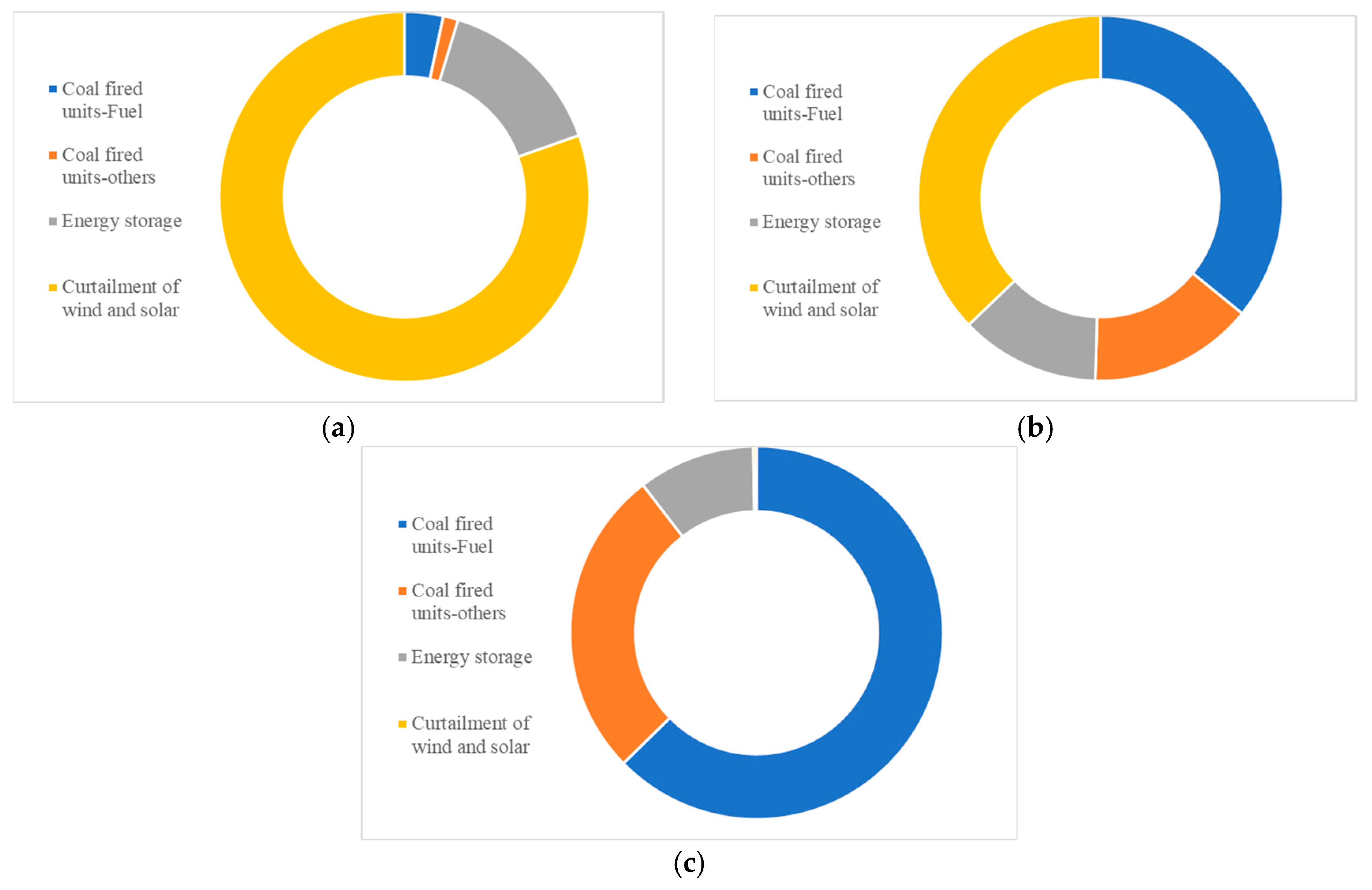A Modeling Study on the Impact of Coal Power in Wind–Solar–Thermal Storage System
Abstract
1. Introduction
2. Materials and Methods
2.1. System Description
2.2. Model Introduction
2.3. Model Function
3. Results and Discussion
3.1. Flexible Power Regulation Requirements
- (1)
- Actual scenario. In the scenario where the load range of the scheduled curve is between 23.3% and 66.7% of the installed capacity for both wind and solar power, the combined power generation from these sources approximated 60% of the electricity demand;
- (2)
- Ideal scenario. In the scenario where the load range of the scheduled curve is between 14% and 40% of the installed capacity for both wind and solar power, the total power generation from these sources approximated 100% of the electricity demand;
- (3)
- Extreme scenario. In the scenario where the load range of the scheduled curve is between 4.7% and 13.3% of the installed capacity for both wind and solar power, the total power generation from these sources approximated 300% of the electricity demand.
3.2. Effect of Coal-Fired Power on the Environment
3.3. Effect of Coal-Fired Power on Operating Cost
4. Conclusions
- (1)
- When the scheduled load range was significantly lower than the installed capacity of wind and solar power, that is, when the combined power generation from wind and solar power sources reaches approximately 300% of the demand, these sources contribute to 90% of the required power, equipping coal-fired power units, whose installed capacity was greater than 5% of the installed capacities of wind and solar power, was necessary to ensure the stable annual power output of the system;
- (2)
- As the ratio of wind and solar power generation to output power decreases, the relationship between coal-fired unit installed capacity and the wind and solar curtailment rates of the system transitions from monotonic to nonmonotonic. Additionally, the effect of the minimum operating load of these units on the curtailment rate grew progressively more significant. The operational cost savings from decreasing the minimum operation load of coal-fired power units surpassed those obtained by either reducing the installed capacity of coal-fired power units or energy storage devices;
- (3)
- Under the research conditions of this study, the lowest operational cost was observed when wind and solar power generation constituted 76% of the total and a stable power output was ensured for 95% of the days in the given year. In this scenario, the curtailment rate of wind and solar power was 11.3%, the daily energy supply from energy storage devices was 1000 MWh, Lcoal,min was 10%, and the Rcoal was 25%;
- (4)
- When the ratio of wind and solar power generation to output power was 91%, 76%, and 58%, a 1% reduction in the coal consumption rate of coal-fired units during low-load operation caused a decrease in the total system operating costs of 0.012%, 0.093%, and 0.089%, respectively.
Author Contributions
Funding
Data Availability Statement
Conflicts of Interest
Abbreviations
| LCOE | Levelized cost of electricity |
| CNY | Chinese Yuan |
References
- Ma, S.; Wang, M.; Han, T.; Song, H.; Zang, B.; Lu, D.; Chen, W. Kinetic experimental study on desorption of decarbonization solution using ammonia method. Chem. Eng. J. 2013, 217, 22–27. [Google Scholar] [CrossRef]
- Yang, N.; Kang, F.; Zhang, K.; Zhou, Y.; Lin, W.-F. A strategy for CO2 capture and utilization towards methanol production at industrial scale: An integrated highly efficient process based on multi-criteria assessment. Energy Convers. Manag. 2023, 293, 117516. [Google Scholar] [CrossRef]
- Tuttle, J.F.; Powell, K.M. Analysis of a thermal generator’s participation in the Western Energy Imbalance Market and the resulting effects on overall performance and emissions. Electr. J. 2019, 32, 38–46. [Google Scholar] [CrossRef]
- Liu, J.Z.; Zeng, D.L.; Tian, L.; Gao, M.M.; Wang, W.; Niu, Y.G.; Fang, F. Control strategy for operating flexibility of coal-fired power plants in alternate electricity power systems. Proc. CSEE 2015, 35, 5385–5394. [Google Scholar] [CrossRef]
- Zhao, P.; Wang, J.; Dai, Y. Capacity allocation of a hybrid energy storage system for power system peak shaving at high wind power penetration level. Renew. Energy 2015, 75, 541–549. [Google Scholar] [CrossRef]
- Kopiske, J.; Spieker, S.; Tsatsaronis, G. Value of power plant flexibility in power systems with high shares of variable renewables: A scenario outlook for Germany 2035. Energy 2017, 137, 823–833. [Google Scholar] [CrossRef]
- Wang, C.; Song, J. Performance assessment of the novel coal-fired combined heat and power plant integrating with flexibility renovations. Energy 2023, 263, 125886. [Google Scholar] [CrossRef]
- Trieb, F.; Liu, P.; Koll, G. Thermal Storage Power Plants (TSPP)—Operation modes for flexible renewable power supply. J. Energy Storage 2022, 50, 104282. [Google Scholar] [CrossRef]
- Zhang, X.; Gao, Z.; Zhou, B.; Guo, H.; Xu, Y.; Ding, Y.; Chen, H. Advanced Compressed Air Energy Storage Systems: Fundamentals and Applications. Engineering 2024, 34, 246–269. [Google Scholar] [CrossRef]
- Ouyang, T.; Xie, S.; Pan, M.; Qin, P. Peak-shaving scheme for coal-fired power plant integrating flexible carbon capture and wastewater treatment. Energy Convers. Manag. 2022, 256, 115377. [Google Scholar] [CrossRef]
- Kahrl, F.; Lin, J.; Liu, X.; Hu, J. Sunsetting coal power in China. iScience 2021, 24, 102939. [Google Scholar] [CrossRef] [PubMed]
- Wang, H.; Ouyang, Z.; Ding, H.; Su, K.; Zhang, J.; Hu, Y. Experimental study on the flexible peak shaving with pulverized coal self-preheating technology under load variability. Energy 2024, 289, 129830. [Google Scholar] [CrossRef]
- Zhu, S.; Hui, J.; Lyu, Q.; Ouyang, Z.; Zeng, X.; Zhu, J.; Liu, J.; Cao, X.; Zhang, X.; Ding, H.; et al. Experimental study on pulverized coal swirl-opposed combustion preheated by a circulating fluidized bed. Part A. Wide-load operation and low-NOx emission characteristics. Energy 2023, 284, 128573. [Google Scholar] [CrossRef]
- Serrano-Sanchez, C.; Olmeda-Delgado, M.; Petrakopoulou, F. Exergy and Economic Evaluation of a Hybrid Power Plant Coupling Coal with Solar Energy. Appl. Sci. 2019, 9, 850. [Google Scholar] [CrossRef]
- Ding, Z.; Hou, H.; Duan, L.; Hu, E.; Zhang, N.; Song, J. Performance analysis and capacity optimization of a solar aided coal-fired combined heat and power system. Energy 2022, 239, 122141. [Google Scholar] [CrossRef]
- Li, X.; Wang, Y.; Zhang, X.; Li, B.; Xu, Y.; Chen, H.; Sheng, S. Increasing Coal-Fired Power Plant Operational Flexibility by Integrating Solar Thermal Energy and Compressed Air Energy Storage System. J. Therm. Sci. 2023, 32, 2032–2047. [Google Scholar] [CrossRef]
- Masenga, B.; Byiringiro, J.; Kagiri, C.; Mharakurwa, E.; Ngoma, D.; Aristid, G. Design and Development of Wind-Solar Hybrid Power System with Compressed Air Energy Storage for Voltage and Frequency Regulations. J. Power Energy Eng. 2023, 11, 1–24. [Google Scholar] [CrossRef]
- Zhou, B.; Liu, D.; Zhang, J.; Li, Y.; Xu, E.; Bi, S. Research of optimal allocation of multi-energy complementary project of wind-solar-thermal integration. Power Gener. Technol. 2022, 43, 10–18. [Google Scholar] [CrossRef]
- Wang, R.; Liu, M.; Zhao, Y.; Zhou, B.; Hui, X. Low Carbon Scheduling Technology for Wind-PV-thermal-storage System Bsen on Carbon Trading and Carbon Capture Cost Balance. Renew. Energy Resour. 2023, 41, 562–568. [Google Scholar] [CrossRef]
- Antoniadou-Plytaria, K.-E.; Kouveliotis-Lysikatos, I.-N.; Georgilakis, P.-S.; Hatziargyriou, N.-D. Distributed and Decentralized Voltage Control of Smart Distribution Networks: Models, Methods, and Future Research. IEEE Trans. Smart Grid 2017, 8, 2999–3008. [Google Scholar] [CrossRef]
- Happ, H.-H. Optimal power dispatch—A comprehensive survey. IEEE Trans. Power Appar. Syst. 1977, 96, 841–854. [Google Scholar] [CrossRef]
- Al-falahi, M.D.A.; Jayasinghe, S.D.G.; Enshaei, H. A review on recent size optimization methodologies for standalone solar and wind hybrid renewable energy system. Energy Convers. Manag. 2017, 143, 252–274. [Google Scholar] [CrossRef]
- An, Y.; Zheng, S.; Su, Y.; Yang, R. Research on Two-layer Optimization of Wind-solar- water-storage Multi Energy Complementary Power Generation System. Acta Energ. Solaris Sin. 2023, 44, 510–517. [Google Scholar] [CrossRef]
- Rehman, S.; Menesy, A.S.; Zayed, M.E.; Al-Shaikhi, A.; Mohandes, M.A.; Irshad, K.; Kassas, M.; Abido, M.A. Synergistic sizing and energy management strategy of combined offshore wind with solar floating PV system for green hydrogen and electricity co-production using multi-objective dung beetle optimization. Results Eng. 2025, 25, 104399. [Google Scholar] [CrossRef]
- Shboul, B.; Zayed, M.E.; Al-Tawalbeh, N.; Usman, M.; Irshad, K.; Odat, A.-S.; Alam, M.A.; Rehman, S. Dynamic numerical modeling and performance optimization of solar and wind assisted combined heat and power system coupled with battery storage and sophisticated control framework. Results Eng. 2024, 22, 102198. [Google Scholar] [CrossRef]
- Liu, N.; Kang, J.; Zhao, C. Development Model of Multi-energy Complementary Energy Base and Comprehensive Benefit Enhancement Method. Proc. CSEE 2024, 44, 1339–1352. [Google Scholar] [CrossRef]
- Sartori da Silva, F.; Matelli, J.A. Script for resilience analysis in energy systems: Python programming code and partial associated data of four cogeneration plants. Data Brief 2021, 36, 106986. [Google Scholar] [CrossRef]
- Xu, Y.; Yang, K.; Yuan, J. Levelized cost of offshore wind power in China. Environ. Sci. Pollut. Res. 2021, 28, 25614–25627. [Google Scholar] [CrossRef]
- Fang, Y.; Li, G.; Li, S. Analysis of Optimal to Inverter Power Ratio and LCOE of PV Power Generation System. Sol. Energy 2023, 36–43. [Google Scholar] [CrossRef]
- Kee, Z.; Wang, Y.; Pye, J.; Rahbari, A. Small-scale concentrated solar power system with thermal energy storage: System-level modelling and techno-economic optimization. Energy Convers. Manag. 2023, 294, 117551. [Google Scholar] [CrossRef]
- Fuentealba, E.; Ferrada, P.; Araya, F.; Marzo, A.; Parrado, C.; Portillo, C. Photovoltaic performance and LCOE comparison at the coastal zone of the Atacama Desert, Chile. Energy Convers. Manag. 2015, 95, 181–186. [Google Scholar] [CrossRef]
- Xiang, C.; Xu, X.; Zhang, S.; Qian, H.; Duan, Z. Current situation of small and medium-sized pumped storage power stations in Zhejiang Province. J. Energy Storage 2024, 78, 110070. [Google Scholar] [CrossRef]
- Yun, P.; Wu, H.; Alsenani, T.R.; Bouzgarrou, S.M.; Alkhalaf, S.; Alturise, F.; Almujibah, H. On the utilization of artificial intelligence for studying and multi-objective optimizing a compressed air energy storage integrated energy system. J. Energy Storage 2024, 84, 110839. [Google Scholar] [CrossRef]
- Wang, Y.; Sun, Y.; Zhang, Y.; Chen, X.; Shen, H.; Liu, Y.; Zhang, X.; Zhang, Y. Optimal modeling and analysis of microgrid lithium iron phosphate battery energy storage system under different power supply states. J. Power Sources 2022, 521, 230931. [Google Scholar] [CrossRef]
- Wen, J.; Liu, N.; Pei, J.; Xu, R.; Liu, D. Life Cycle Cost Analysis for Energy Storage Technology. Therm. Power Gener. 2021, 50, 24–29. [Google Scholar] [CrossRef]
- Zhao, C.; Zhang, W.; Wang, Y.; Liu, Q.; Guo, J.; Xiong, M.; Yuan, J. The economics of coal power generation in China. Energy Policy 2017, 105, 1–9. [Google Scholar] [CrossRef]
- Jia, Z.; Qian, L. Analysis on the influence of deep peak regulation on carbon emission of 660 MW coal-fired thermal power unit. In Collection of 2023 Papers on Technical Supervision of the Power Industry and Technical Forum (Volume II); China Electricity Technology Market Association: Beijing, China, 2023; p. 6. [Google Scholar] [CrossRef]
- Wei, H.; Lu, Y.; Yang, Y.; Zhang, C.; He, C.; Wu, Y.; Li, W.; Zhao, D. Research on influence of steam extraction parameters and operation load on operational flexibility of coal-fired power plant. Appl. Therm. Eng. 2021, 195, 117226. [Google Scholar] [CrossRef]
- Yuan, J.; Ai, Y.; Zeng, Y.; Liu, Q.; Ouyang, M. Research on China’s coal-fired power generation cost and on-grid tariff policy. Coal Econ. Res. 2018, 38, 43–48. [Google Scholar] [CrossRef]
- Jiang, L.; Wang, C.; Huang, Y.; Pei, Z.; Xin, S.; Wang, W.; Ma, S.; Brown, T. Growth in Wind and Sun: Integrating Variable Generation in China. IEEE Power Energy Mag. 2015, 13, 40–49. [Google Scholar] [CrossRef]











| Value of n | Operational Load Range | Value of bn, g/kWh |
|---|---|---|
| 1 | 10–20% of power unit capacity | 530 |
| 2 | 20–30% of power unit capacity | 440 |
| 3 | 30–40% of power unit capacity | 380 |
| 4 | 40–50% of power unit capacity | 340 |
| 5 | >50% of power unit capacity | 310 |
Disclaimer/Publisher’s Note: The statements, opinions and data contained in all publications are solely those of the individual author(s) and contributor(s) and not of MDPI and/or the editor(s). MDPI and/or the editor(s) disclaim responsibility for any injury to people or property resulting from any ideas, methods, instructions or products referred to in the content. |
© 2025 by the authors. Licensee MDPI, Basel, Switzerland. This article is an open access article distributed under the terms and conditions of the Creative Commons Attribution (CC BY) license (https://creativecommons.org/licenses/by/4.0/).
Share and Cite
Liu, Y.; Lyu, Q.; Gao, Z.; Zhu, S.; Fu, J.; Liu, Y.; Gao, M.; Chai, Z. A Modeling Study on the Impact of Coal Power in Wind–Solar–Thermal Storage System. Energies 2025, 18, 2819. https://doi.org/10.3390/en18112819
Liu Y, Lyu Q, Gao Z, Zhu S, Fu J, Liu Y, Gao M, Chai Z. A Modeling Study on the Impact of Coal Power in Wind–Solar–Thermal Storage System. Energies. 2025; 18(11):2819. https://doi.org/10.3390/en18112819
Chicago/Turabian StyleLiu, Yuhua, Qinggang Lyu, Zhengnan Gao, Shujun Zhu, Jinming Fu, Yongjiang Liu, Ming Gao, and Zhen Chai. 2025. "A Modeling Study on the Impact of Coal Power in Wind–Solar–Thermal Storage System" Energies 18, no. 11: 2819. https://doi.org/10.3390/en18112819
APA StyleLiu, Y., Lyu, Q., Gao, Z., Zhu, S., Fu, J., Liu, Y., Gao, M., & Chai, Z. (2025). A Modeling Study on the Impact of Coal Power in Wind–Solar–Thermal Storage System. Energies, 18(11), 2819. https://doi.org/10.3390/en18112819





